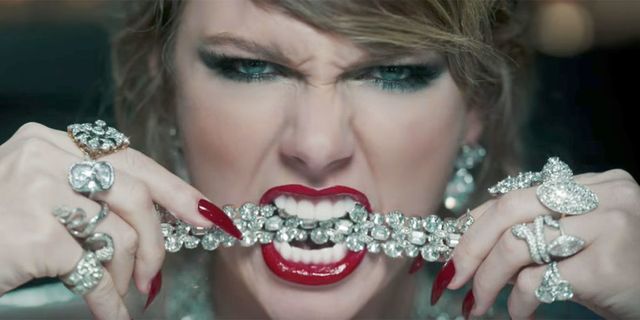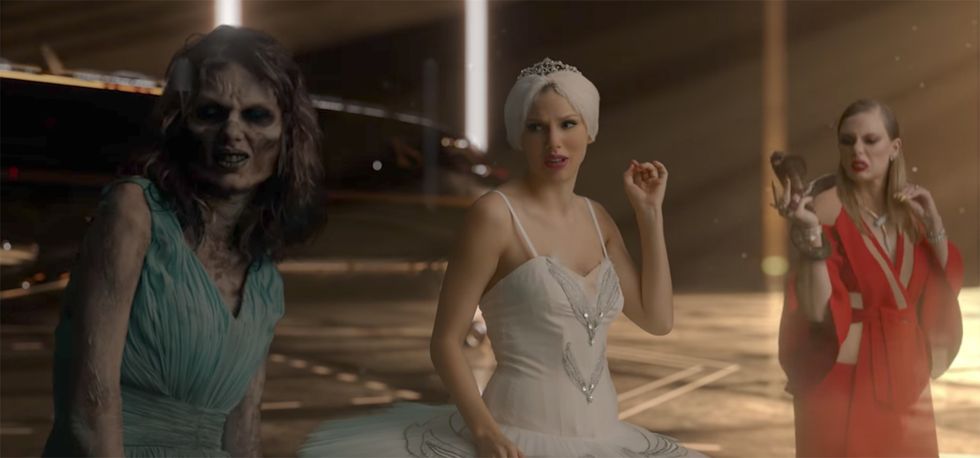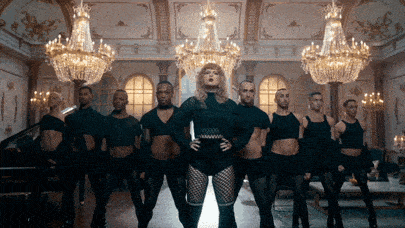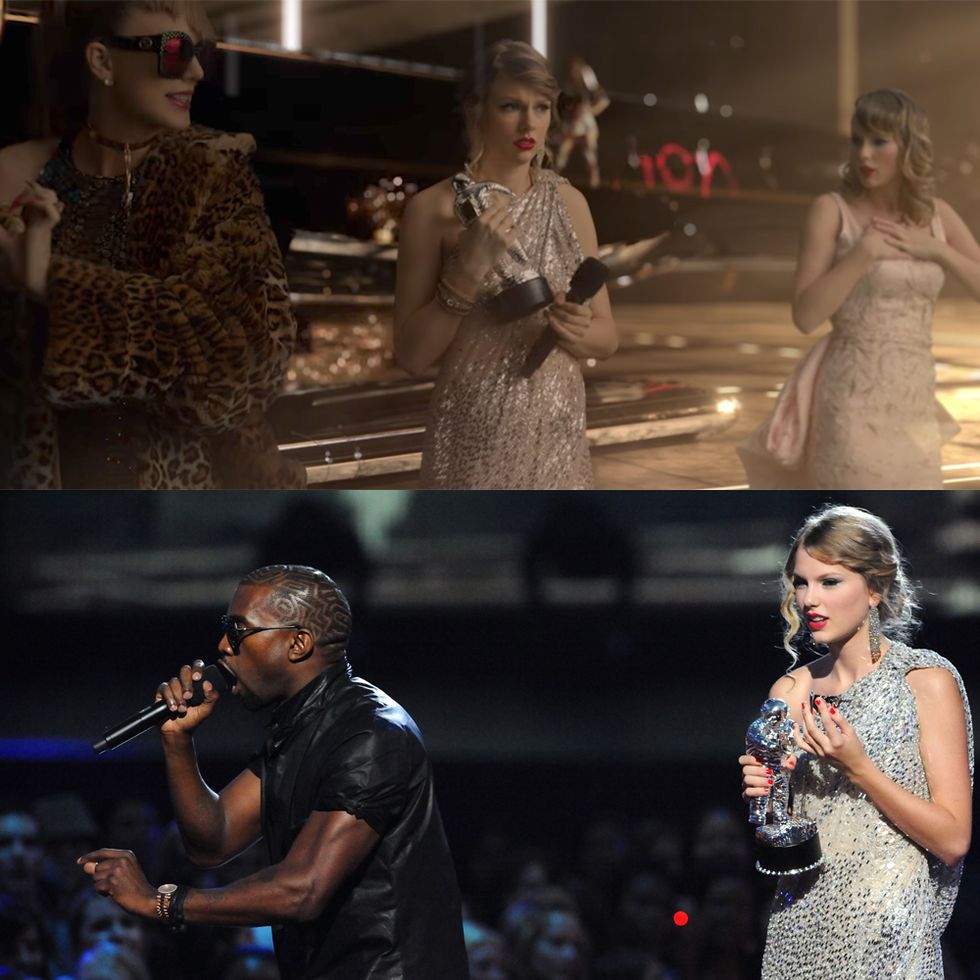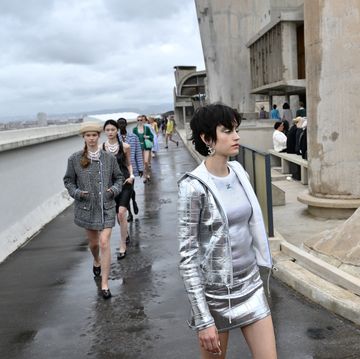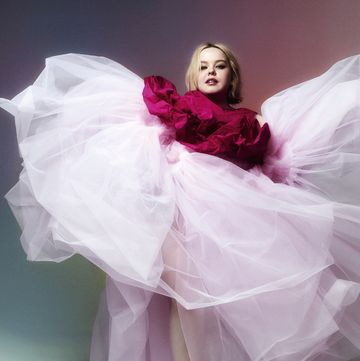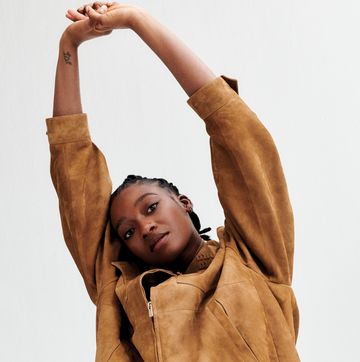Sunday night's MTV Video Music Awards were defiantly political. Artists called for compassion on matters of race, gender, and depression, and rallied against the rhetorical violence of President Trump and its literal enactment by his right-wing followers. Robert Wright Lee, a descendant of confederate general Robert E. Lee, spoke out against racism, "America's original sin." He then introduced Susan Bro, mother of Heather Heyer, the young woman killed in Charlottesville, who announced an anti-hatred foundation in her daughter's name. MTV invited transgender members of the military along after Trump announced he was banning them from service. In a night dedicated to earnest pop culture displays of unity, the self-obsessed video for Taylor Swift's comeback single "Look What You Made Me Do" stuck out like a can of Pepsi at a protest.
It did make sense for Swift to premiere the clip at the VMAs. She's won seven of them, her first being the 2009 award for Best Female Video for "You Belong With Me"—which became a life-changing event for the wrong reasons when Kanye West interrupted her acceptance speech to say that Beyoncé had been robbed. It set off a chain reaction that's still going, and this video is just the latest link. Directed by Joseph Kahn ("Bad Blood," "Blank Space"; Britney's "Toxic"), it's a high-concept manifestation of the voicemail in "LWYMMD," in which Swift declares "the old Taylor" dead; we see her dressing up as and mocking her past incarnations.
Each scene is similarly dense with nods to her past public scandals: recurring snake imagery references her spat with West and Kim Kardashian. A flank of dancers in "I <3 T.S." crop tops call back to a much-ridiculed moment featuring ex-boyfriend Tom Hiddleston, and winks at Swift's reputation as a master of her own image. (To wit: The shirts are already on sale in her merch store.) She and a gang of cat burglars break into the generic "Stream Co." and burn piles of money, invoking the accusations of greed that followed her public protests against Apple Music and Spotify, and she assumes a dictator persona to control an army of potential #squad drones.
There's been a level of self-mockery to Swift's work for a while now—think "some indie record that's much cooler than mine," the riffs on her awkwardness in the "Shake It Off" video, and "Blank Space," a perfect send-up of her propensity to use ex-boyfriends as songwriting chattel. But the video for "LWYMMD" is on another level compared to those cartoonish exploits. Leaning into the darkest parts of her public persona, the video is spectacularly, almost impressively aggressive. As she transforms from evil incarnation to evil incarnation, she appears brittle, like she's about to short-circuit with rage.
She may make fun of herself, but she's not shy about lining up some other targets here. When Swift lies in a bath filled with diamonds and "one symbolic dollar," she's probably referring to her recent court case win against DJ David Mueller. But do her gun fingers also imply a crueller reference to Kim Kardashian being robbed at gunpoint? In another sequence, she crashes a gold car just like the one that appears in nemesis Katy Perry's "Waking Up in Vegas" video. Swift is also uncannily styled to look like Perry's current incarnation: blonde hair flip, pink lipstick. The only difference is she's clutching one of her 10 Grammys—probably a dig at Perry, who hasn't won any. This character reappears at the end, collecting "receipts" in her phone to "edit" later. If anything shows the "death" of the Old Taylor, it's this confusing composite of Perry and Kardashian that feels out of place among the variations on Swift's own identity.
There's something thrilling about Swift destroying the contract of relatability that she's spent over a decade so carefully establishing (and which is expected of almost any young woman in the public eye). "LWYMMD" doesn't just supercede the breezy message of "Shake It Off"—it is almost obsessively vindictive, a portrait of a slighted queen bee poring over catalogued slights and weaving them into a barbed tapestry. Yet, contrary to the song's claims, "Old Taylor" is clearly far from dead. Swift's Type A tendencies are all present and correct here. She seems determined to show that if revenge is the game, she will stop at nothing to out-maneuver and humiliate any enemy: "I've got a list of names and yours is in red underlined," she warns.
But, for once, the Type A play hasn't proven a winner on every metric. "LWYMMD"'s manic, packed production feels completely out of step with the cool, playful vibes of the summer's biggest songs and their videos—Dua Lipa's effortlessly intricate "New Rules," Kesha's "Praying," Calvin Harris' "Feels," Lorde's "Perfect Places." And the all-out spectacle feels especially myopic during a politically proactive moment for pop. Regardless of the video's conceptual acrobatics, Swift is still playing the passive victim, forced to inhabit this merciless character by her many opponents: Look what you made her do. But since nobody else is in the ring, she seems to be shadowboxing.
"LWYMMD" is funny and audacious in some ways, and seems like something of a risk for Swift's career—but it's not the kind of risk that counts in 2017. (It obviously hasn't proven a financial risk, given the song's various streaming and sales highs.) Unlike the many celebrities speaking out about party politics and injustice, Swift has kept out of the fray. There's no way Swift could have pulled off a political reinvention after the #feminist awakening of the 1989 era was undermined by her persistent digs at Katy Perry and her silence around the 2016 election. And she didn't really try—for instance, the bare-shouldered Swift from the polling station line didn't make an appearance in the video. But the song's relentless focus on slights against her—a privileged, wealthy, white pop star—grate even more in the current political context.
In this, "LWYMMD" demonstrates hyper-awareness, but not real self-awareness or a willingness to understand Swift's own role in these scandals. Twitter went off when it spotted similarities between Beyoncé's Lemonade and a preview of Swift's video. But more than the surface parallels, Swift's demand for a deep, intertextual read of every reference does feel like her trying to do a Lemonade, which offered fans a rich poetic, visual, and cinematic curriculum about black womanhood that accentuated the depth and breadth of Beyoncé's project. By contrast, "LWYMMD" feels like an insular Easter egg binge.
The video's most telling moment is also its subtlest, or at least as subtle as an engraving on a gold throne surrounded by CGI snakes can be. Beneath Swift's long claws tapping on the armrest appear the words from the infamous betrayal scene in Shakespeare's Julius Caesar: "Et tu, Brute?" On the day "LWYMMD" was released, none of Swift's once highly visible squad had tweeted a word about the song (though certain members did get a shout-out on a T-shirt). It wouldn't be surprising if this had been coordinated by Swift herself, wanting to shut down the chummy 1989-era vibe. But the silence suits the isolated aesthetic of Swift's new posture: the maligned ingénue forced to retreat to her gothic tower and wreak vengeance. "I don't trust nobody and nobody trusts me," she quips: There may be 15 different incarnations of her lined up at the end of the video, a shambolic army of discontents, but in the Reputation era, Taylor Swift is completely alone.
